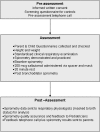Lung function and respiratory symptoms at 11 years in children born extremely preterm: the EPICure study
- PMID: 20378729
- PMCID: PMC2913237
- DOI: 10.1164/rccm.200912-1806OC
Lung function and respiratory symptoms at 11 years in children born extremely preterm: the EPICure study
Abstract
Rationale: The long-term respiratory sequelae of infants born extremely preterm (EP) and now graduating from neonatal intensive care remains uncertain.
Objectives: To assess the degree of respiratory morbidity and functional impairment at 11 years in children born EP (i.e., at or less than 25 completed weeks of gestation) in relation to neonatal determinants and current clinical status.
Methods: Pre- and postbronchodilator spirometry were undertaken at school in children born EP and classroom control subjects. Physical examination and respiratory health questionnaires were completed. Multivariable regression was used to estimate the predictive power of potential determinants of lung function.
Measurements and main results: Spirometry was obtained in 182 of 219 children born EP (129 with prior bronchopulmonary dysplasia [BPD]) and 161 of 169 classmates, matched for age, sex, and ethnic group. Children born EP had significantly more chest deformities and respiratory symptoms than classmates, with twice as many (25 vs. 13%; P < 0.01) having a current diagnosis of asthma. Baseline spirometry was significantly reduced (P < 0.001) and bronchodilator responsiveness was increased in those born EP, the changes being most marked in those with prior BPD. EP birth, BPD, current symptoms, and treatment with beta-agonists are each associated independently with lung function z-scores (adjusted for age, sex, and height) at 11 years. Fifty-six percent of children born EP had abnormal baseline spirometry and 27% had a positive bronchodilator response, but less than half of those with impaired lung function were receiving any medication.
Conclusions: After extremely preterm birth, impaired lung function and increased respiratory morbidity persist into middle childhood, especially among those with BPD. Many of these children may not be receiving appropriate treatment.
Figures



References
-
- Martin JA, Hamilton BE, Sutton PD, Ventura SJ, Menacker F, Kirmeyer S, Munson ML. National Vital Statistics Reports, Vol. 56, Number 6, pp. 1–104: Births: final data for 2005. Hyattsville, MD: National Center for Health Statistics, U.S. Department of Health and Human Services; 2007. - PubMed
-
- Draper ES, Zeitlin J, Fenton AC, Weber T, Gerrits J, Martens G, Misselwitz B, Breart G. Investigating the variations in survival rates for very preterm infants in 10 European regions: the MOSAIC birth cohort. Arch Dis Child Fetal Neonatal Ed 2009;94:F158–F163. - PubMed
-
- Saigal S, Doyle LW. An overview of mortality and sequelae of preterm birth from infancy to adulthood. Lancet 2008;371:261–269. - PubMed
Publication types
MeSH terms
Substances
Grants and funding
LinkOut - more resources
Full Text Sources
Other Literature Sources
Medical

